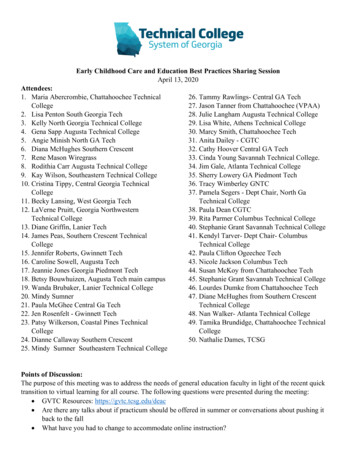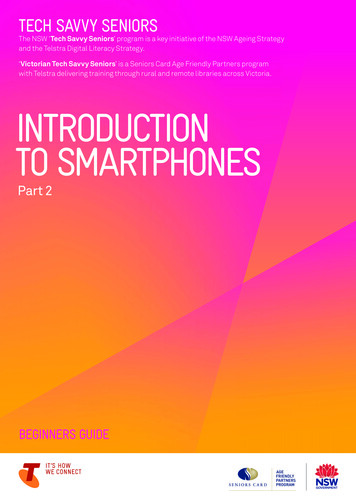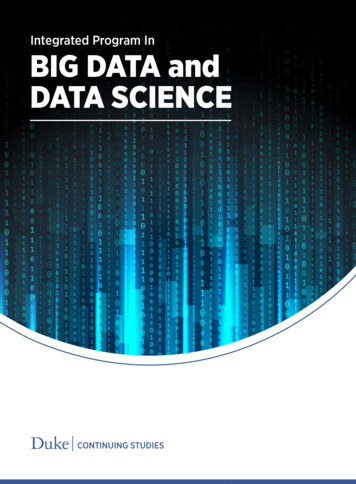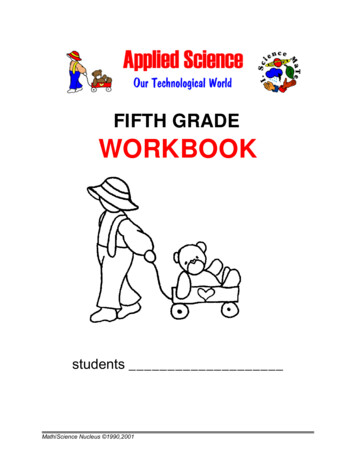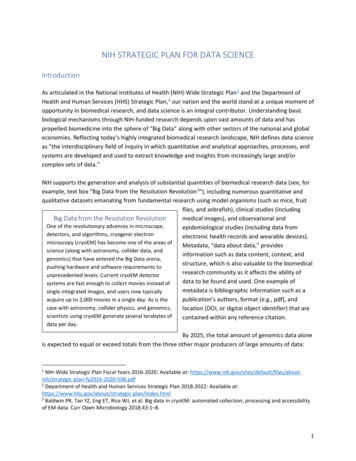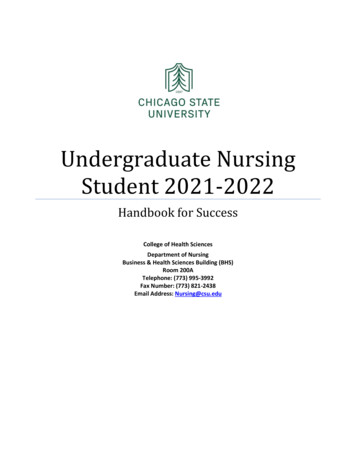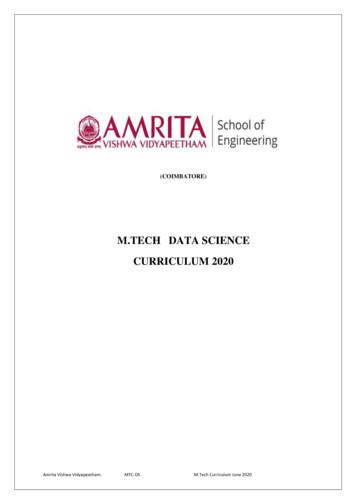
Transcription
(COIMBATORE)M.TECH DATA SCIENCECURRICULUM 2020Amrita Vishwa Vidyapeetham.MTC-DSM.Tech Curriculum June 2020
GENERAL INFORMATIONCourse Outcome (CO) – Statements that describe what students are expected to know, and are able to do at theend of each course. These relate to the skills, knowledge and behaviour that students acquire in their progressthrough the course.Program Outcomes (POs) – Program Outcomes are statements that describe what students are expected to nowand be able to do upon graduating from the Program. These relate to the skills, knowledge, attitude andbehaviour that students acquire through the program. NBA has defined the Program Outcomes for eachdiscipline.PROGRAM OUTCOMES FOR ENGINEERING Engineering knowledge: Apply the knowledge of mathematics, science, engineering fundamentals, and anengineering specialization to the solution of complex engineering problems.Problem analysis: Identify, formulate, review research literature, and analyze complex engineeringproblems reaching substantiated conclusions using first principles of mathematics, natural sciences, andengineering sciences.Design/development of solutions: Design solutions for complex engineering problems and design systemcomponents or processes that meet the specified needs with appropriate consideration for the public healthand safety, and the cultural, societal, and environmental considerations.Conduct investigations of complex problems: Use research-based knowledge and research methodsincluding design of experiments, analysis and interpretation of data, and synthesis of the information toprovide valid conclusions.Modern tool usage: Create, select, and apply appropriate techniques, resources, and modern engineeringand IT tools including prediction and modelling to complex engineering activities with an understanding ofthe limitations.The engineer and society: Apply reasoning informed by the contextual knowledge to assess societal,health, safety, legal and cultural issues and the consequent responsibilities relevant to the professionalengineering practice.Environment and sustainability: Understand the impact of the professional engineering solutions insocietal and environmental contexts, and demonstrate the knowledge of, and need for sustainabledevelopment.Ethics: Apply ethical principles and commit to professional ethics and responsibilities and norms of theengineering practice.Individual and team work: Function effectively as an individual, and as a member or leader in diverseteams, and in multidisciplinary settings.Communication: Communicate effectively on complex engineering activities with the engineeringcommunity and with society at large, such as, being able to comprehend and write effective reports anddesign documentation, make effective presentations, and give and receive clear instructions.Project management and finance: Demonstrate knowledge and understanding of the engineering andmanagement principles and apply these to one’s own work, as a member and leader in a team, to manageprojects and in multidisciplinary environments.Life-long learning: Recognize the need for, and have the preparation and ability to engage in independentand life-long learning in the broadest context of technological change.Amrita Vishwa Vidyapeetham.MTC-DSM.Tech Curriculum June 2020
SEMESTER ICat.CodeTitleLTPCreditFC20MA604Computational Linear Algebra and Optimizationfor Data Sciences3014SC20DS611Introduction to Machine Learning2013FC20DS601Algorithms and Structures for Data Science2013SC20DS612Real Time Operating System for EmbeddedComputing2013SC20DS613Embedded Computing for Data Science2013SC20RM600Research Methodology2002HU18HU601Amrita Value ProgramsP/FHU18HU602Career Competency - IP/FTOTAL18SEMESTER IICat.CodeTitleLTPCreditSC20DS614Machine Learning for Signal Processing andPattern Classification2013FC20DS602Probabilistic Graphical Models2013SC20DS615Scientific Computing2013SC20DS616Computer Networks and IOT2013EElective-I2013EElective-II2013Career Competency - II0011HU18HU603TOTALAmrita Vishwa Vidyapeetham.MTC-DSM.Tech Curriculum June 202019
SEMESTER IIICat.CodeTitleLTPCreditSC20DS617Big Data Framework for Data tation0088P20DS798TOTAL17SEMESTER IVCat.CodeTitleLTPCreditP20DS799Dissertation0 0 1212TOTAL12Total Credits66List of CoursesFoundation CoreCourseCodeCourseLTPCredits20MA604Computational Linear Algebra and Optimization for Data Sciences3 0 1420DS601Algorithms and Structures for Data Science2 0 1320DS602Probabilistic Graphical Models2 0 13LTPCreditsSubject CoreCourseCodeCourse20DS611Introduction to Machine Learning201320DS612Real Time Operating System for Embedded Computing201320DS613Embedded Computing for Data Science201320DS614Machine Learning for Signal Processing and Pattern Classification2013Amrita Vishwa Vidyapeetham.MTC-DSM.Tech Curriculum June 2020
20DS615Scientific Computing201320DS616Computer Networks and IOT201320DS617Big Data Framework for Data Science201320RM600Research Methodology2002PROFESSIONAL ELECTIVESCatCodeTitleLTPCreditsE20DS701Digital Control Systems2013E20DS702Multivariable Control Systems2013E20DS703Deep Learning in Genomic and Biomedicine2013E20DS704Deep Learning for Biomedical Data Analysis2013E20DS705Speech Processing2013E20DS706Deep Learning for NLP2013E20DS707Social Media Analytics2013E20DS708Deep Learning for Visual Recognition2013E20DS709Deep Learning for Cyber security2013E20DS710Computational Fluid Dynamics2013E20DS711Deep Learning Essential for Self-Driving Car2013E20DS712Introduction to Additive nmanned Aerial Vehicles and Essential ControlComputational Robotics and Robotic OperatingSystemComplex Systems in Engineering, Finance & Biology:Modelling & Analysis2013E20DS716Introduction to Data Analysis2013Amrita Vishwa Vidyapeetham.MTC-DSM.Tech Curriculum June 2020
SYLLABUSSEMESTER I20MA604COMPUTATIONAL LINEAR ALGEBRA AND OPTIMIZATION FOR DATA SCIENCESL-T-P-C: 3-0- 1- 4Course Objectives The course will lay down the basic concepts and techniques of linear algebra, calculus andoptimization theory needed for subsequent study. It will explore the concepts initially through computational experiments and then try tounderstand the concepts/theory behind it. At the same time, it will provide an appreciation of the wide application of these disciplineswithin the scientific field. Another goal of the course is to provide connection between the concepts of linear algebra,differential equation and optimization theory.Course OutcomesCO1: Use computational techniques and algebraic skills essential for the study of systems of linearequations, matrix algebra, vector spaces, eigenvalues and eigenvectors, orthogonality anddiagonalization. (Computational and Algebraic Skills).CO2: Use visualization, spatial reasoning, as well as geometric properties and strategies to model,solve problems, and view solutions, especially in R2 and R3.CO3: Conceptually extend these results to higher dimensions. (Geometric Skills) and critically analyseand construct mathematical arguments that relate to the study of introductory linear algebra. (Proof andReasoning).CO-PO MappingPO/PSOPO1 atrices and Gaussian Elimination – Introduction, Geometry of Linear Equations, Gaussian Elimination, Matrixmultiplication, Inverses and Transposes, Special matrices and applications. Vector spaces and Linear equations–Vector spaces and subspaces, linear independence, basis and dimension, the four fundamental subspaces.Orthogonality - Perpendicular vectors and orthogonal subspaces, inner products and projections onto lines,projections and least square applications, orthogonal basis, orthogonal spaces, orthogonal matrices, GramSchmidt orthogonalization, FFT. Eigenvalues and Eigenvectors – Introduction, diagonal form of a matrix,difference equations and the powers of A k, Positive Definite Matrices - Minima, Maxima and saddle points,tests for positive definiteness, semi-definite and indefinite matrices, Singular Value Decomposition, iterativemethods for Ax b, applications in sparse signal and image processing. Introduction - mathematicaloptimization, least-squares and linear programming, convex and nonlinear optimization. Convex sets, Convexoptimization problems - optimization problem in standard form, convex optimization problems, quasi-convexAmrita Vishwa Vidyapeetham.MTC-DSM.Tech Curriculum June 2020
optimization, linear optimization, quadratic optimization, generalized inequality constraints, semi definiteprogramming, vector optimization. Duality, Approximation and fitting, Statistical estimation, Geometricproblems, Unconstrained minimization- gradient descent method, steepest descent method, Newton's method.Equality constrained minimization - equality constrained minimization, eliminating equality constraints,Newton's method with equality constraints, infeasible start Newton method, implementation. Interior-pointmethods -inequality constrained minimization, logarithmic barrier function and central path, barrier method, L1Norm Optimization methods,Alternating direction method of multipliers (ADMM), Applications in Signal and Image Processing.Textbooks / ReferencesGilbert Strang, ―Linear Algebra and its Applications‖, Third Edition, Harcourt College Publishers, 1988.Gene H. Golub and V. Van Loan, ―Matrix Computations‖, Third Edition, John Hopkins University Press,Baltimore, 1996.David C. Lay, ―Linear Algebra and Its Applications‖, Pearson Addison Wesley, 2002.Stephen P. Boyd and Lieven Vandenberghe d, Convex Optimization, Cambridge University press, 2004Kalyanmoy Deb, "Optimization for Engineering Design Algorithms and Examples", Prentice Hall of India, NewDelhi, 2004.Edwin K.P. Chong and Stanislaw H. Zak, ―An Introduction to Optimization‖ Second Edition, WileyInterscience Series in Discrete Mathematics and Optimization, 2004.M. Asghar Bhatti, ―Practical Optimization Methods: With Mathematica Applications‖, Springer VerlagPublishers, 2000.Evaluation PatternAssessmentAssignments (8 assignments with equal credit)Weightage (%)20Quiz (6 Quizzes with equal credit)Mid Sem PeriodicalEnd Semester Exam35153020DS611INTRODUCTION TO MACHINE LEARNINGL-T-P-C: 2-0- 1- 3Course Objectives This course dives into the basics of Machine Learning using various tools such as Weka and LibSVMand implementations of Machine Learning algorithms using Python and MATLAB. The students will learn about Supervised Vs Unsupervised Learning, investigate how StatisticalModelling relates to Machine Learning, and do a comparison of each. The students will enrich with the hands-on experience to implement various machine learningalgorithms.Course OutcomesCO1: To understand the fundamentals of patterns recognition and to implement clustering concepts and featureextraction techniques.CO2: To implement the Kernel methods using different machine learning packages such as, Weka andLibSVM.CO3: Understand and apply various algorithms for pattern recognition and gain knowledge on how to applyclassifier to a particular application.Amrita Vishwa Vidyapeetham.MTC-DSM.Tech Curriculum June 2020
CO-PO MappingPO/PSOPO1 The need for Machine Learning – Supervised learning – Unsupervised Learning – Linear regression and Featureselection – Linear Classification – Support Vector Machines – Clustering – Dimensionality Reduction –Graphical – Artificial Neural Networks – Dimensionality Reduction - Combining classifiers - regularization,clustering - Spectral clustering, Reinforcement Learning - Markov models - Large Scale Machine Learning Applications - Introduction to Deep Learning – Deep Learning Architectures – LSTM – CNN – RNN – Hyperparameter tuning – Decision Trees – Machine Learning applied to medical data – ECG – EEG – Deep Learningapplications in medical data – EEG – ECG.Textbooks / ReferencesPattern Recognition and Machine Learning. Bishop, C. M. Springer (2010).Introduction to Machine Learning with Python. Mueller, A. C. & Guido, S. O‘REILLY‘ Publishers (2016).Fundamentals of Deep Learning: Designing Next-Generation Machine Intelligence Algorithms. Buduma, N. &Locascio, N. O‘REILLY‘ Publishers (2017).Introduction to Machine Learning, 2nd Edition. Alpaydin, E. MIT Press (2009).Soman, K. P., Loganathan, R., & Ajay, V. (2009). Machine learning with SVM and other kernel methods. PHILearning Pvt. Ltd.Ethem Alpaydin, ―Introduction to Machine Learning 3e (Adaptive Computation and Machine LearningSeries)‖, Third Edition, MIT Press, 2014Stephen Marsland, ―Machine Learning – An Algorithmic Perspective‖, Second Edition, Chapman andHall/CRC Machine Learning and Pattern Recognition Series, 2014.Tom M Mitchell, ―Machine Learning‖, First Edition, McGraw Hill Education, 2013.Evaluation PatternAssessmentAssignments (6 assignments with equal credit)Weightage (%)20Quiz (4 Quizzes with equal credit)Mid Sem PeriodicalEnd Semester Exam35153020DS601ALGORITHMS AND STRUCTURES FOR DATA SCIENCEL-T-P-C: 2-0- 1- 3Course Objectives This course aims at introducing the concept of data structure hierarchy. It will also expose the students to the basic and higher order data structures. Further the students will be motivated to apply the concept of data structures to various engineeringproblems.Amrita Vishwa Vidyapeetham.MTC-DSM.Tech Curriculum June 2020
Course OutcomesCO1: To choose an appropriate data structure as applied to a specified problem.CO2: To introduce various techniques for representation of the data in the real world.CO3: To develop application using data structuresCO4: To improve the logical abilityCO-PO MappingPO/PSOPO1 ------3233SyllabusAlgorithm Analysis - Methodologies for Analyzing Algorithms, Asymptotic Notation, A Quick MathematicalReview, Case Studies in Algorithm Analysis, Amortization, Experimentation .Basic Data Structures - Stacksand Queues, Vectors, Lists, and Sequences, Trees, Priority, Queues and Heaps, Dictionaries and Hash Tables.Search Trees and Skip Lists - Ordered Dictionaries and Binary Search Trees, AVL Trees. Bounded-DepthSearch Trees, Splay Trees, Skip Lists. Sorting, Sets, and Selection - Merge-Sort, Abstract Data Type, QuickSort, A Lower Bound on Comparison-Based Sorting, Bucket-Sort and Radix-Sort, Comparison of SortingAlgorithms, Selection. Fundamental Techniques - The Greedy Method, Divide-and-Conquer, DynamicProgramming.Graphs - Abstract Data Type Data Structures for Graphs, Graph Traversal. Directed Graphs ,Weighted Graphs, Single-Source Shortest Paths, All-Pairs Shortest Paths, Minimum Spanning Trees, NetworkFlow and Matching, Flows and Cuts. Additional Topics- Computational Geometry, Range Trees, PrioritySearch Trees, Quadtrees and k-D Trees, the Plane Sweep Technique, Convex Hulls. NP-Completeness - P andNP, NP-Completeness, Important NP-Complete Problems.Textbooks / ReferencesMichael T. Goodrich and Roberto Tamassia, ―Algorithm Design Foundations, Analysis and InternetExamples‖, John Wiley and Sons, 2003.Michael T. Goodrich and Roberto Tamassia, ―Data Structures and Algorithms in C ‖, John Wiley and Sons,2003.Michael T. Goodrich and Roberto Tamassia, ―Data Structures and Algorithms in Java‖, Fourth Edition, JohnWiley and Sons, 2004.Evaluation PatternAssessmentAssignments (6 assignments with equal credit)Weightage (%)20Quiz (4 Quizzes with equal credit)Mid Sem PeriodicalEnd Semester Exam35153020DS612REAL TIME OPERATING SYSTEM FOR EMBEDDED COMPUTINGL-T-P-C:2-0-1-3Course Objective The course will provide an introductions to limitations of the micro controls for some of the real-timeapplications and need of RTOSThe students will understand the various computational resources which are very much necessary forthe time critical operations and applicationsAmrita Vishwa Vidyapeetham.MTC-DSM.Tech Curriculum June 2020
The course will provide the implementation of RTOS system using open source microcontrollers andRTOS software platforms.Course OutcomeCO 1: Introducing the limitations of micro-controllers in embedded system based on the computing resourcesCO 2:Understanding timing sub-system in micro-controllersCO 3:Understanding and implementation of time and priority management using Free-RTOS and Atmega328CO-PO 1CO233322------133333CO333333------1--3333COPO8 PO9PO10 PO11 PO12 PSO1PSO2SyllabusProgramming languages intended for real time systems, Introduction to Real time operating system (RTOS),System support: scheduling, resource handling, Design and analysis of real time system software, Modelling andverification of real time systems, Reliability and fault tolerance, Interrupts, Fault recovery, Distributed real timesystems, Real time communication, Real time systems for multiprocessor systemsTextbooks / ReferencesLiu, Jane W. S., Real-time systemsUpper Saddle River, N.J.: Prentice Hall, cop. 2000Rajib Mall, "Real-Time Systems: Theory and Practice," Pearson, 2008.Jane W. Liu, "Real-Time Systems" Pearson Education, 2001.Krishna and Shin, "Real-TIme Systems," Tata McGraw Hill. 1999.Evaluation PatternAssessmentAssignments (6 assignments with equal credit)Weightage (%)20Quiz (4 Quizzes with equal credit)Mid Sem PeriodicalEnd Semester Exam35153020DS613EMBEDDED COMPUTING FOR DATA SCIENCEL-T-P-C:2-0-1-3Course Objective The course will provide the importance and applications of embedded systems in modern applicationsThe course will paves the way for understanding the various sources of data stream from a embeddedsystem point of view and recording this data streams for processingThis will enable the students to develop various system and analyse the data from the developed systemfor decision making.Amrita Vishwa Vidyapeetham.MTC-DSM.Tech Curriculum June 2020
Course OutcomeCO 1: Fundamentals of micro-controller architecture and programming and sources of dataCO 2:Introducing Arduino microcontroller and programming environment and data streaming using varioussensorsCO 3:Real-time application development for automating Aquaponics farming system and various case studiesfrom healthcare, agriculture and automationCO-PO 11CO23322211--133333CO333333111123333COPO8 PO9PO10 PO11 PO12 PSO1PSO2SyllabusIntroduction to Embedded systems, hardware/software code sign, Embedded micro controller cores, embeddedmemories,Basic electronics using Arduino and raspberry pi, Examples of embedded systems, sensors andinterfacing techniques, Real-time concepts, real-time operating systems, Required RTOS services/capabilities(in contrast with traditional OS). Digital Systems- Design of P, PI, and PID controllers. State space and filteringsystems. Motor Controls. Communication systems- System design and simulation on Simulink. Signalprocessing systems- Hardware based on DSP Chips and Microcontrollers, Development environments ofmicrocontrollers and DSP processors. Software development for data acquisition, fundamentals of wirelessnetworks for embedded system, Interfacing and Integration of microcontroller based systems. Examples ofIndustrial process automation, software development using python, introduction to data streams and analytics.Data visualization using python tools,Machine learning techniques on sensor data streamsTextbooks / ReferencesD. Gajski, F. Vahid, S. Narayan, and J. Gong.―Specification and Design of Embedded Systems‖, PEARSONEducation, 1994Syaunstrup and W. Wolf. ―Hardware Software Co-design: Principles and Practice‖, Kluwer,AcademicPublishers, 1997Python Programming with Raspberry Pi Paperback – Import, 28 Apr 2017 by Sai Yamanoor and SrihariYamanoorEvaluation PatternAssessmentAssignments (6 assignments with equal credit)Weightage (%)20Quiz (4 Quizzes with equal credit)Mid Sem PeriodicalEnd Semester Exam35153020RM600RESEARCH METHODOLOGYL-T-P-C: 2-0- 0- 2SyllabusUnit I:Meaning of Research, Types of Research, Research Process, Problem definition, Objectives of Research,Research Questions, Research design, Approaches to Research, Quantitative vs. Qualitative Approach,Amrita Vishwa Vidyapeetham.MTC-DSM.Tech Curriculum June 2020
Understanding Theory, Building and Validating Theoretical Models, Exploratory vs. Confirmatory Research,Experimental vs Theoretical Research, Importance of reasoning in research.Unit II:Problem Formulation, Understanding Modeling & Simulation, Conducting Literature Review, Referencing,Information Sources, Information Retrieval, Role of libraries in Information Retrieval, Tools for identifyingliteratures, Indexing and abstracting services, Citation indexesUnit III:Experimental Research: Cause effect relationship, Development of Hypothesis, Measurement Systems Analysis,Error Propagation, Validity of experiments, Statistical Design of Experiments, Field Experiments, Data/VariableTypes & Classification, Data collection, Numerical and Graphical Data Analysis: Sampling, Observation,Surveys, Inferential Statistics, and Interpretation of ResultsUnit IV:Preparation of Dissertation and Research Papers, Tables and illustrations, Guidelines for writing the abstract,introduction, methodology, results and discussion, conclusion sections of a manuscript. References, Citation andlisting system of documentsUnit V:Intellectual property rights (IPR) - patents-copyrights-Trademarks-Industrial design geographical indication.Ethics of Research- Scientific Misconduct- Forms of Scientific Misconduct. Plagiarism, Unscientific practicesin thesis work, Ethics in science.Textbooks / ReferencesBordens, K. S. and Abbott, B. B., ―Research Design and Methods – A Process Approach‖, 8th Edition,McGraw-Hill, 2011C. R. Kothari, ―Research Methodology – Methods and Techniques‖, 2nd Edition, New Age InternationalPublishersDavis, M., Davis K., and Dunagan M., ―Scientific Papers and Presentations‖, 3rd Edition, Elsevier Inc.Michael P. Marder,― Research Methods for Science‖, Cambridge University Press, 2011T. Ramappa, ―Intellectual Property Rights Under WTO‖, S. Chand, 2008Robert P. Merges, Peter S. Menell, Mark A. Lemley, ―Intellectual Property in New Technological Age‖. AspenLaw & Business; 6 edition July 2012.Evaluation PatternAssessmentAssignments (6 assignments with equal credit)Weightage (%)20Quiz (4 Quizzes with equal credit)Mid Sem PeriodicalEnd Semester Exam351530Amrita Vishwa Vidyapeetham.M.Tech Curriculum June 2020MTC-DS
SEMESTER II20DS614MACHINE LEARNING FOR SIGNAL PROCESSING AND PATTERN CLASSIFICATIONL-T-P-C: 2-0- 1- 3Course Objectives This course dives into the basics of Machine Learning for signal processing and pattern classification. This course helps to learn different feature extraction approaches from various signals. Students will learn to implement various pattern recognition tasks using machine learning / deeplearning algorithms. Students will learn to use pre-trained models for deep learning.Course OutcomesCO1: To apply advanced optimization based de-noising methods to recover original signal.CO2: To implement advanced decomposition methods such as, Empirical Wavelet Transform, VariationalMode Decomposition, Empirical Mode Decomposition and analyse the signal.CO3: To implement the Kernel methods using different machine learning packages such as, Weka, LibSVMand GURLS. And also to implement deep learning architectures for signal classification.CO-PO MappingPO/PSOPO1 Introduction to real world signals - speech, image. Feature extraction and front-end signal processing information rich representations, robustness to noise and artifacts, signal enhancement, bio inspired featureextraction. Basics of pattern recognition, Discriminative modelling - support vector machines, neural networksand back propagation. Introduction to deep learning - convolutional and recurrent networks, pre-training andpractical considerations in deep learning, understanding deep networks. Clustering methods and decision trees.Applications in computer vision and speech recognition.Textbooks / ReferencesPattern Recognition and Machine Learning, C.M. Bishop, 2nd Edition, Springer, 2011.Deep Learning, I. Goodfellow, Y, Bengio, A. Courville, MIT Press, 2016.Digital Image Processing, R. C. Gonzalez, R. E. Woods, 3rd Edition, Prentice Hall, 2008. d.Fundamentals of speech recognition, L. Rabiner and H. Juang, Prentice Hall, 1993.Deep Learning: Methods and Applications, Li Deng, Microsoft Technical Report.Automatic Speech Recognition - Deep learning approach - D. Yu, L. Deng, Springer, 2014.Computer Vision: Algorithms and Applications, R. Szeliski, Springer, 2010Amrita Vishwa Vidyapeetham.MTC-DSM.Tech Curriculum June 2020
Evaluation PatternAssessmentAssignments (6 assignments with equal credit)Weightage (%)20Quiz (4 Quizzes with equal credit)Mid Sem PeriodicalEnd Semester Exam35153020DS602PROBABILISTIC GRAPHICAL MODELSL-T-P-C: 2-0- 1- 3Course Objectives The main objective of the course is to introduce the fundamental concepts of probabilistic graphicalmodels. To explore the applications of probability theory and graphical models in data analysis. To provide connection between the concepts of mathematics and computational thinking withprobabilistic graphical models.Course OutcomesAfter completing this course, the students will be able toCO1: Model engineering problems using the fundamental concepts of probabilityCO2: Apply the concept of probabilistic graphical models to solve problems pertinent to data science.CO3:Analyse different probabilistic models developed for describing a given system.CO-PO MappingPO/PSOPO1 Samples, Events, Event space, Probability Space, Random Variables, Independence and ConditionalIndependence, Conditional Probability, Joint Probability, Bayes' theorem Joint and Marginal Probability,Estimation Theory - Maximum Likelihood Estimators. Probabilistic Graphical Models: Direct and undirectedmodel, Inference from Direct and undirected graphical model, Structured and Unstructured graphical models,Partition Function, D-Separation, Energy based models, Factor Graphs, Sampling from Graphical Models.Monte-Carlo Methods: Markov Chain and Monte-Carlo methods, Gibbs Sampling, Approximate Inference –Expectation Maximization, MAP Inference. Special cases: HMM, CRF, Kalman Filter.Textbooks / ReferencesKoller, Daphne, and Nir Friedman. Probabilistic graphical models: principles and techniques. MIT press,2009.Ian Goodfellow, Yoshua Bengio and Aaron Courville, Deep Learning, MIT press 2016Amrita Vishwa Vidyapeetham.MTC-DSM.Tech Curriculum June 2020
Evaluation PatternAssessmentAssignments (6 assignments with equal credit)Weightage (%)20Quiz (4 Quizzes with equal credit)Mid Sem PeriodicalEnd Semester Exam35153020DS615SCIENTIFIC COMPUTINGL-T-P-C: 2-0- 1- 3Course Objectives This course helps students to understand the latest computational techniques. This course helps students to understand the concept of partial differential equations and the ways tosolve those equations. This course aims to help students to implement the computational methods using MATLAB and Python.Course OutcomesAfter completing this course, the students will be able toCO1: Develop a basic understanding of computational schemes used to solve differential equations.CO2: Analyse problems pertinent to data science using novel computational techniques.CO3:Model different engineering/physical/natural systemsCO-PO -33--3COSyllabusRoot finding: Functions and polynomials, zeros of a function, roots of a nonlinear equation, bracketing,bisection, secant, and Newton-Raphson methods. Interpolation, splines, polynomial fits, Chebyshevapproximation. Numerical Integration and Differentiation: Evaluation of integrals, elementary analyticalmethods, trapezoidal and Simpson’s rules, Romberg integration, Gaussian quadrature and orthogonalpolynomials, multidimensional integrals, summation of series, Euler-Maclaurin summation formula, numericaldifferentiation and estimation of errors. Ordinary differential equations: Lipschitz condition, solutions in closedform, power series method. Numerical methods: error analysis, stability and convergence, Euler and RungeKutta methods, multistep methods, Adams-Bashforth and Adams-Moulton methods, Gear’s open and closedmethods, predictor-corrector methods.Numerical solution of PDEs: relaxation methods for elliptic PDEs, Crank-Nicholson method for parabolicPDEs, Lax-Wendroff method for hyperbolic PDEs. Calculus of variations and variational techniques for PDEs,integral equations. Finite element method and finite difference time domain method, method of weightedresiduals, weak and Galerkin forms, ordinary and weighted/general least squares. Fitting models to data,parameter estimation using PDEs. Iterative methods for Solution of linear matrix equations.Textbooks / ReferencesKutz, J. Nathan, Data-Driven Modeling & Scientific Computation: Methods for Complex Systems & Big Data,Oxford University press,Arfken, G.B., and Weber, H.J., Mathematical Methods for Physicists, Sixth Edition, Academic Press, 2005.Amrita Vishwa Vidyapeetham.MTC-DSM.Tech Curriculum June 2020
Evaluation PatternAssessmentAssignments (6 assignments with equal credit)Weightage (%)20Quiz (4 Quizzes with equal credit)Mid Sem PeriodicalEnd Semester Exam35153020DS616COMPUTER NETWORKS AND IOTL-T-P-C: 2-0- 1- 3Course Objectives The primary course objective is to provide the importance of computer networks. Enable the student to understand the fundamental networking principles, standards, protocols andtechnologies. The course also provide insig
20DS613 Embedd ed Computing for Data Science 2 0 1 3 20DS614 Machine Learning for Signal Processing and Pattern Classification 2 0 1 3 . Amrita Vishwa Vidyapeetham. MTC-DS M.Tech Curric


